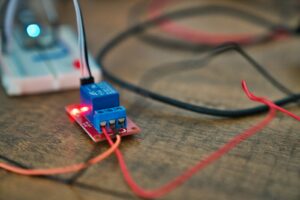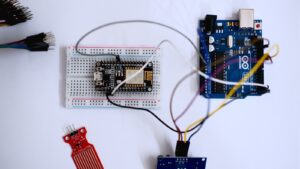How IoT Security Vulnerabilities Lead to Exploitation
The insufficient security configurations in IoT devices present a major challenge, leading to potential exploitation. In regions like Saudi Arabia and the UAE, where the adoption of smart technologies is accelerating, the implications of weak IoT security are profound.
The Risks of Inadequate IoT Security Configurations
One of the critical issues with many IoT devices is that they often come with default settings that are rarely changed by users. These default configurations may include weak passwords, open ports, and outdated firmware, which can be easily exploited by cybercriminals. Such vulnerabilities can lead to unauthorized access, data breaches, and even control over the device. For instance, in smart home systems, inadequate security can allow attackers to manipulate devices such as cameras, thermostats, and door locks, posing significant privacy and safety risks.
In industrial settings, the stakes are even higher. IoT devices are integral to operations in sectors like energy, manufacturing, and transportation. A compromised IoT device in these environments can disrupt critical infrastructure, leading to operational downtime, financial losses, and potential safety hazards. The interconnected nature of IoT systems means that a single exploited device can serve as a gateway to the entire network, amplifying the impact of a security breach.
Case Studies of IoT Exploitation
Several high-profile cases have highlighted the dangers of inadequate IoT security configurations. For example, the Mirai botnet attack in 2016 exploited weak default credentials in IoT devices to launch a massive distributed denial-of-service (DDoS) attack, affecting major websites and internet services worldwide. This incident underscored the need for robust security measures and the risks associated with neglecting them.
In the Middle East, where smart city projects are gaining momentum, the potential for IoT exploitation is a significant concern. Cities like Riyadh and Dubai are integrating IoT solutions to enhance urban living and operational efficiency. However, these advancements must be accompanied by stringent security protocols to safeguard against potential cyber threats. The emphasis on cybersecurity in these projects is crucial to maintaining public trust and ensuring the seamless operation of smart city initiatives.
Steps to Ensure Proper Security Settings in IoT Devices
To mitigate the risks associated with insufficient security configurations in IoT devices, several steps can be taken. First, manufacturers must prioritize security during the design and development of IoT products. This includes implementing strong default settings, such as unique passwords for each device, secure communication protocols, and regular firmware updates to address vulnerabilities. Manufacturers should also provide clear guidelines and tools for users to customize their security settings effectively.
Second, users play a crucial role in maintaining IoT security. It is essential to change default passwords, regularly update firmware, and disable unnecessary features that could be exploited. Educating users about the importance of these practices and providing user-friendly security management tools can significantly enhance overall security. In corporate settings, IT departments should enforce policies and procedures for securing IoT devices, including network segmentation and continuous monitoring for suspicious activities.
Strategies for Enhancing IoT Security
Implementing Comprehensive Security Frameworks
Developing and implementing comprehensive security frameworks is vital for protecting IoT ecosystems. These frameworks should encompass all aspects of IoT security, from device manufacturing to end-user deployment. Key components include strong authentication mechanisms, encryption of data both at rest and in transit, and secure boot processes to prevent unauthorized firmware modifications.
In Saudi Arabia and the UAE, where digital transformation is a key strategic goal, adopting international security standards and best practices can bolster IoT security efforts. Collaborations between government agencies, industry leaders, and cybersecurity experts can lead to the development of robust regulatory frameworks that ensure IoT devices meet stringent security requirements before they are deployed in the market.
Utilizing Artificial Intelligence and Machine Learning
Artificial intelligence (AI) and machine learning (ML) technologies can significantly enhance IoT security by providing advanced threat detection and response capabilities. AI and ML algorithms can analyze vast amounts of data generated by IoT devices to identify patterns indicative of malicious activities. These technologies can detect anomalies in real-time, enabling swift action to mitigate potential threats.
In Dubai, smart city projects are increasingly leveraging AI and ML to enhance cybersecurity. For example, AI-driven analytics platforms can monitor traffic patterns across IoT networks, identifying and blocking suspicious activities before they can cause harm. This proactive approach to security helps maintain the integrity and reliability of smart city infrastructure, ensuring that residents and businesses can trust the technology that supports their daily lives.
Fostering a Culture of Security Awareness
Creating a culture of security awareness is essential for the long-term success of IoT security initiatives. This involves educating all stakeholders, including manufacturers, developers, users, and policymakers, about the importance of IoT security and the best practices for maintaining it. Regular training sessions, awareness campaigns, and collaborative efforts can foster a security-first mindset across the IoT ecosystem.
In Riyadh, initiatives aimed at raising cybersecurity awareness are gaining traction. Workshops and seminars organized by industry associations and government bodies provide valuable insights into emerging threats and the latest security measures. By staying informed and proactive, stakeholders can collectively contribute to a more secure IoT landscape, reducing the risk of exploitation and ensuring the safe integration of IoT devices into various aspects of life and business.
Conclusion
Ensuring robust security configurations in IoT devices is critical for preventing exploitation and safeguarding the benefits of IoT technology. The integration of IoT into energy management, smart cities, and various industrial applications in Saudi Arabia and the UAE underscores the importance of addressing security vulnerabilities. By implementing comprehensive security frameworks, leveraging AI and ML technologies, and fostering a culture of security awareness, stakeholders can mitigate risks and enhance the reliability of IoT systems. As the adoption of IoT continues to grow, prioritizing security will be essential for realizing the full potential of this transformative technology.
#IoTSecurity #Cybersecurity #IoTVulnerabilities #SmartCities #SaudiArabia #UAE #Riyadh #Dubai #ArtificialIntelligence #Blockchain #ModernTechnology #BusinessSuccess #LeadershipSkills #ProjectManagement













